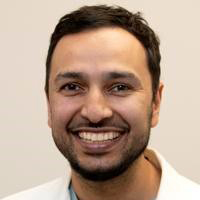Conversations With Cardiologists: Mustafa I. Ahmed, MD

Mustafa I. Ahmed, MD
Mustafa I. Ahmed, MD, is an interventional cardiologist and structural heart disease specialist at the University of Alabama at Birmingham (UAB) where he serves as director of the Cardiovascular Network, Interventional Cardiology and the Cath Lab, and the program director of the Structural Heart Disease Program. He is active in translational and clinical research in structural heart disease, coronary and structural intervention.
What led you to pursue structural and interventional cardiology?
As a child, I saw the devastating effects of heart disease firsthand, but I also saw the life-changing effects and hope offered through treatments. My dream was to pursue either cardiology or heart surgery. Medical school and early training reinforced that. I spent several years undertaking translational research evaluating the role of imaging, cellular mechanisms of disease, medical treatments, and the timing and effect of surgical treatment on mitral valve disease. I loved the evaluation and management process of heart disease and did not want to give that up. I wanted to directly treat these issues; such as repairing a valve that was dysfunctional. Structural heart intervention was a very new and exciting field with unlimited potential. I saw an opportunity for a career on the cutting-edge that provided the ability to see a patient through an entire journey. After interventional fellowship, I spent additional time training in imaging and structural intervention which at the time was more of an opportunistic endeavor since structured training programs did not yet exist, so in a way I grew along with the field. The rest is history!
What advice do you have for general and interventional cardiology fellows interested in pursuing training in structural cardiology?
See as many patients as you can and follow patient journeys through from presentation to evaluation to treatment to follow-up. Absolutely identify mentors that resonate with what you want to do with your career. Seek positive influences. Maximize time in your cath lab, critical care, TEE and other imaging rotations. Attend every heart team meeting you can. Lastly, don't be scared to leave your comfort zone or location to pursue training and career development opportunities.
Structural cardiology training is currently non-accredited. What should an effective training program be like? How can prospective fellows best approach the structural fellowship match?
If you are spending a year of your life pursuing dedicated structural training, I recommend seeking the most comprehensive, high volume, hands-on training program you can find. There needs to at minimum be a commitment to developing independent proficiency in the basics such as TAVR, transcatheter edge-to-edge repair, patent foramen ovale closure and left atrial appendage occlusion. Ideally, there should be exposure to advanced coronary work and advanced support device insertion. If possible, exposure to tricuspid and congenital interventions would be available for a well-rounded experience. It is always a helpful experience to be exposed to clinical trials investigating new devices since structural technology is advancing rapidly. It's critical that structural fellows are there to train and develop; not simply to be used as service provision. The programs must be committed to this. I always recommend speaking to several of the previous fellows of the program prior to or as part of the application process.
Can you provide insight into the current job market for structural fellows?
Structural heart intervention is a competitive specialty. There are very few jobs where individuals are simply turning up and doing structural work, yet most people seem to focus on the availability of those jobs as defining the market. I would avoid that way of looking at the job market. Even in my job as a busy structural interventionalist, I balance a mix between general/interventional, inpatient/outpatient, structural heart disease inpatient/outpatient and cath lab time. Personally, I find this more varied and satisfying. Evaluation and identification of structural heart pathology is increasing, and newer interventions are in trial or becoming commercially available constantly. The reality is that structural programs in some form will likely be incorporated into any hospital offering interventional services. For those that are well-trained across a broad spectrum of coronary and structural interventions, there will likely always be a demand. As with any competitive specialty, certain markets or geographic locations may be saturated and prove more difficult to get a foot in the door.
Can you share some tips for securing desired job positions after completing structural cardiology training?
Start your job search as early as possible; even before you begin structural training. Cast a broad and wide net and look at different types of jobs that you feel may be the best fit for you. Don't commit to the first thing that seems a good idea; look around. Ensure the mentors you have had along the way are involved in discussing different jobs that you look at and their advantages, disadvantages and considerations with regard to opportunities, politics and more. Nothing we take will be perfect and the grass will always seem greener. It's the foundation for success that is important. The rest is what we make of it.

This article was authored by Amr Salama, MD, an interventional cardiology Fellow in Training at University of Alabama Birmingham. Twitter: @Salama_AmrA.
This content was developed independently from the content developed for ACC.org. This content was not reviewed by the American College of Cardiology (ACC) for medical accuracy and the content is provided on an "as is" basis. Inclusion on ACC.org does not constitute a guarantee or endorsement by the ACC and ACC makes no warranty that the content is accurate, complete or error-free. The content is not a substitute for personalized medical advice and is not intended to be used as the sole basis for making individualized medical or health-related decisions. Statements or opinions expressed in this content reflect the views of the authors and do not reflect the official policy of ACC.
